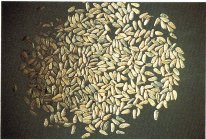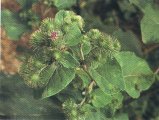Arctium Seed
http://www.100md.com
《e Natural Health Center》
 |
 |
 |
Herbs for Dispelling Wind and Heat
Arctium Seed
Latin:
Fructus Arctii
Origin:
Being the seed of a coarse weed Arctium Lappa L., a biennial plant, of Compositae family, that is commonly found in waste places. It blooms during the summer and fall months, averaging 5-10 cm in height.
, 百拇医药
The lower leaves are heart-shaped, entire or somewhat toothed. The rest of the leaves are egg-shaped and they all have hollow leaf stalks. The purple flowers grow in bristly heads 1 cm wide to 2 cm wide in fruit, producing prickly, clinging burs. These flower heads are stalkless or short-stalked.
In China, the plant is mainly produced in Hebei, Zhejiang, etc., picked and reaped in autumn, dried in the sun and used when raw or after frying. Mash it for use.
, 百拇医药
The plant is also known as Common Burdock.
Properties:
Sweet in flavor, cold in nature, it is related to the lung and stomach channels.
Functions:
Dispels pathogenic wind-heat, promotes eruption, relieves sore throat, removes toxic substances and subdues swelling.
The plant is also used extensively by American Indians in root tea as a "blood purifier", a diuretic, as a stimulus for bile secretion, sweating, also used for gout, liver and kidney ailments, rheumatism and gonorrhea.
, http://www.100md.com
Chinese used leafy branches in tea to treat vertigo, rheumatism and measles (mixed with brown sugar). Also used externally as a wash for hives, eczema and other skin eruptions.
The seeds have been used for abscesses, sore throats, insect and snake bites, flu, constipation, bruises and once used to treat scarlet fever, smallpox and scrofula.
The crushed leaves have been placed on burns, ulcers and sores.
, http://www.100md.com
Applications:
1. Used for common colds due to pathogenic wind-heat and sore throat :
As this herb is so pungent as to be dispersing, so bitter as to be purging and so cold as to reduce fever, it can dispel pathogenic wind-heat, ventilate the lungs and relieve sore throat; often used in combination with weeping forsythia fruit (Fructus Forsythiae), honeysuckle flower (Flos Lonicerae), jingjie (Herba Schizonepetae), balloon flower root (Radix Platycodi), etc., e.g., Yin Qiao San, for the treatment of common colds and sore throat due to pathogenic wind-heat; it can be used together with Chaulmoogra tree seed (Semen Hydnocarpi), peppermint, fangfeng (Radix Ledebouriellae), etc., e.g., Niubang Tang, for the treatment of sore throat due to excessive wind-heat and greater toxic heat; often used in combination with jingjie (Herba Schizonepetae), balloon flower root (Radix Platycodi), purple-flowered peucedanum root (Radix Peucedani) and licorice for coughing due to pathogenic wind-heat and obstructed abundant expectoration.
, http://www.100md.com
2. Used for measles without eruption:
Being refreshing, purging and dispersing, this herb can dispel pathogenic wind-heat, purge toxic heat and promote the eruption of measles, so it is often used in combination with peppermint, jingjie (Herba Schizonepetae), cicada slough, Asian poccoon root (Radix Arnebiae seu Lithospermi), etc., e.g., Tou Zhen Tang, for the treatment of measles without adequate eruption or measles appearing first and later disappearing again.
, 百拇医药
3. Used for carbuncles, ulcers, mumps and pharyngitis (inflammation of the pharynx):
Being pungent in taste, cold in nature, with lifting as well as lowering properties, this herb can disperse pathogenic wind-heat off the exterior and purge toxic substances from the interior, so it can reduce fever, dispel toxic substances, subdue swelling and relieve sore throat, and as it also has lubricating properties, it can relax the bowels and induce diuresis; it is often used together with Chaulmoogra tree seed (Semen Hydnocarpi), mirabilite, cape jasmine fruit (Fructus Gardeniae), weeping forsythia fruit (Fructus Forsythiae), peppermint, etc., for the treatment of attacks of wind-heat syndrome on the exterior, the internal retention of fire-toxins, carbuncles and ulcers with constipation; used in combination with Mongolian snakegourd fruit (Fructus Trichosanthis), weeping forsythia fruit (Fructus Forsythiae), Chinese trichosanthes root (Radix Trichosanthis), dried green orange peel, etc., e.g., Guawei Niubang Tang, for the treatment of stagnation of the liver-qi with fire transmission and acute mastitis (inflammation of the breast) due to the obstruction of channels by stomach-heat; used together with Zhejiang figwort root (Radix Scrophulariae), skullcap root (Radix Scutellariae), Chinese goldthread rhizome (Rhizoma Coptidis), dyers wood root (Radix Isatidis), etc., e.g., Puji Xiaodu Yin, for the treatment of cheek inflammation caused by virulent pathogens, mumps and pharyngitis.
, 百拇医药
Dosage and Administration:
3-10 g.
Decoct the ingredients for drinking. Its cold nature will be slightly reduced if the herb is fried for use.
Cautions on Use:
This herb should be used carefully by those who have loose stools with qi-deficiency because it is warm in nature and it lubricates and relaxes the bowels.
, http://www.100md.com
Leaf hairs may irritate skin.
Reference Materials:
'Methodology of Medication' :
"It has four uses: the treatment of rheumatism and urticaria, the treatment of sore throat due to pathogenic wind-heat, relief from carbuncles, ulcers and other skin diseases and reactivation of the qi stagnated in the loins and knees."
'Compendium of Materia Medica' :
"It eliminates skin eruption toxins."
Toxic or Side Effects:
Modern Researches:
This herb contains arctiin, fatty oil, vitamins A and B1 and alkaloids., 百拇医药